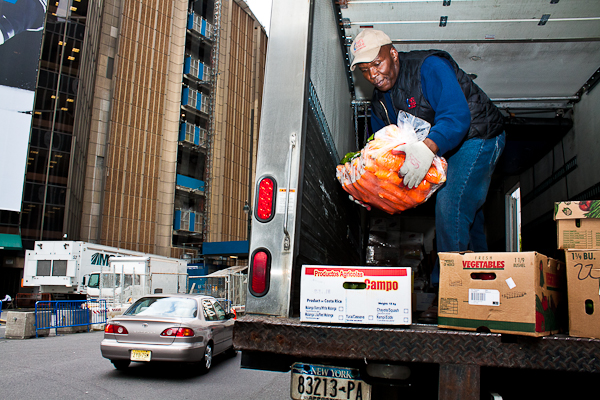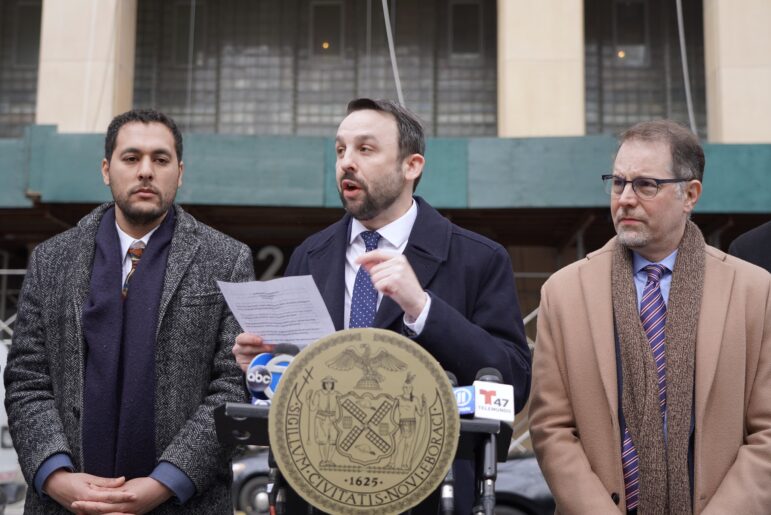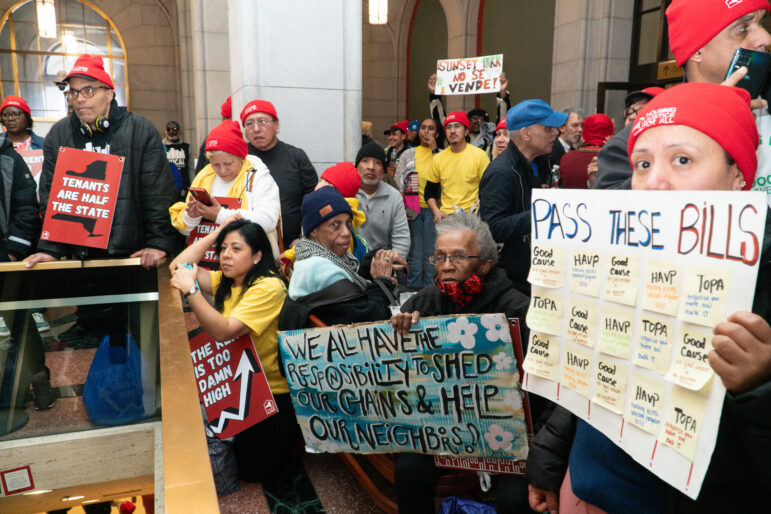
Photo by: Adi Talwar
Pierre Joseph making one of several delivery stops in Manhattan. Attempts to lessen trucks’ outsized impact on traffic and pollution, like scheduling deliveries at night, would require changes in how receiving businesses and consumers operate.
This is the second part of a two-part investigation of New York City’s truck problem. To read part one, click here
The Chef’s Choice truck rolled off the Manhattan Bridge onto Canal Street a little before 10 a.m., headed toward its next stop at a coffee shop on Duane Street. As the truck turned left off Canal, waved on by a police officer directing traffic, a delivery man on a bike sped through the intersection coming the opposite way, narrowly missing a collision. After the turn, a pedestrian jumped out to cross Lafayette Street at mid-block.
Joseph, a 56-year-old Haitian with a slow laugh and a gold tooth that glints when he smiles – which is often – seemed unfazed. After dropping a shipment of meat at the coffee shop, he looped around and headed north on Sixth Avenue. For a delivery truck making a lot of stops, he was saying, the frustrations are simple: too many cars, not enough room.
“The worst part is when you come to a stop and you can find nowhere to park,” he said. “That really gets to you. You keep circling around, circling around. You come back, there’s nothing, you go around again. Meanwhile what could take a half hour takes an hour.”
He pulled in behind a van that was leaving a spot on 14th Street, near another Golden Krust, then put money is a Muni Meter and taped the receipt to the inside of the windshield, next to a clump of others like it. A while later, after Tuckett unloaded boxes of plantains, cabbage and squash, a dour-looking police officer walked up, checked the receipt and moved on without a glance or greeting.
“That’s our enemy,” Joseph said with a grin.
A tide of tickets
The roughly $100 million that the city imposes in parking fines against trucks in a given year has mixed results as a deterrent, planners say – mainly because many shippers chalk the fines up, as with the higher tolls that are sometimes imposed during peak usage hours, as the cost of doing business. Tuckett, a wiry 50-year-old Brooklyn native, agreed.
“See, some companies just accept the tickets, you understand?” he said.
“Us, we gotta be looking out,” he added, because the policy at Chef’s Choice is to avoid the extra expense. “Some [companies], they don’t give a damn.” Certain parcel-delivery companies came to mind. “Ooh,” he said. “They be taking like 10, 15 tickets a day.”
It started to rain at 11 a.m., and at 11:05 they left the spot and turned back onto Sixth Avenue, Joseph deftly swerving to avoid a jaywalker and a pothole. (“Big hole. Giant hole. Could lose a tire,” he smiled.)
Ahead was the truck’s most important – and most difficult – delivery, on 33rd Street next to Madison Square Garden. Two Caribbean restaurants there were awaiting shipment of onions, cabbage, carrots, plantains and oxtail. But there were also dozens of other delivery trucks trying to find room to drop their cargo within a few very crowded blocks.
Drawing close to their destination amid crosstown traffic, Joseph noticed there were no double-parked trucks to be seen. It was an encouraging sign that the crowding, for whatever reason, had momentarily eased.
“That means I got a chance,” he said. Tuckett was not so sure. Madison Square Garden would be busy, he said glumly: “The circus is in town.”
Local impact, far-flung industry
The parking spot, in the end, was not a problem. Driving slowly down 33rd Street between Seventh and Eighth Avenues, Joseph spotted another truck, delivering some kind of metal canisters, that seemed to be ready to leave. He pulled up next to it and put his truck in park, idling in the street until the other truck was ready to go. “Got lucky,” he said, as he backed into the parking space.
The trucks that parked on the block to make deliveries during the hour that the Chef’s Choice truck was there – more than a dozen of them, early on a Wednesday afternoon – came from Manhattan, Brooklyn, Queens, Long Island, New Jersey and Upstate New York, delivering water, linens, electrical supplies and a host of other products.
Holguin-Veras, of Rensselaer, says that kind of variety is a hint at how hard managing truck traffic can be. Even if the port is making strides in regulating its trucks, and even if it is the single largest generator of truck trips, he notes, “It’s tiny compared to the restaurants. And then you add retail stores, etcetera, etcetera, and we’re talking about a lot of deliveries.”
Deliveries have increased in the last five to 10 years, Barone says, leading to an increase in truck traffic. It is, he said, partly the result of a higher cost per square foot of commercial space in the city, which leads businesses to devote as much space as possible to revenue-producing activity and relatively less to storage. That approach, in turn, can require daily deliveries, even multiple deliveries per day, when once a week used to be enough.
Reducing the number of deliveries, while theoretically possible, is a tall order. “You could change demand, but that would require changes in behavior,” Holguin-Veras says. “When you order stuff from the Internet, in particular when you order the fastest way of delivery, you’re forcing the shippers to send it to you without consolidating the cargo.”
In other words, reducing truck trips would require asking consumers to forfeit conveniences that they have come to enjoy. Instead, then, planners have focused on making the trucks flow as smoothly as possible.
A choice of routes
One time-tested method, Barone said, would be to limit parking for cars – or at least the amount of new parking that can be constructed – in order to drive down car traffic, thereby freeing up street space for trucks. This was also, in part, the goal of congestion pricing, and of proposals to toll the East River bridges. The cross-harbor tunnel, which has existed in concept for nearly a century and which Rep. Nadler has championed since the 1990s, would remove many of the trucks crossing the Hudson from local roads and bridges.
Other ideas have included creating special delivery zones in the business district – possibly by piggybacking on the creation of designated bus lanes and using the same space for timed truck deliveries. Such a move would also allow the city to institute variable tolls, to encourage deliveries at less busy times of day.
Much of Holguin-Veras’ work has involved scheduling deliveries at night, when there is less congestion and less competition for curb space. In a pilot program in 2009 and 2010, 25 Manhattan businesses and eight trucking companies agreed to schedule deliveries between 10 a.m. and 8 a.m. The results were striking: Participating trucks’ delivery speeds were more than twice as fast overnight as on comparable trips between 10 a.m. and 10 p.m. Parking fines were sharply reduced, and trucks spent, on average, less than one-third as much time at each delivery site.
The city’s Department of Transportation subsequently began work on an expanded, “more ambitions” version of the program, Holguin-Veras says. If nighttime deliveries could ever be standard procedure for city businesses, he said, the savings for merchants and carriers could add up to as much as $200 million a year.
There is, though, one major obstacle: Shippers and receivers who participated in the pilot program were paid to adjust their schedules. Night deliveries make economic sense for trucking companies, even without a subsidy – but typically, it is the companies receiving the shipments who schedule deliveries. On their end, unless there is a secure place for truck crews to drop their shipments unattended, overnight delivery just means someone has to be at work at weird times.
And as Tuckett put it, dismissing the idea with a shrug, “Who the heck is gonna be there?”
Dreams of a helicopter
Truck crews, though, are not in the business of transportation planning; they make their rounds within the system as it exists. As such, at 12:25 Joseph and Tuckett drove from 33rd Street up Eighth Avenue to 39th Street, where they delivered fish, oxtails, vegetables and sacks of rice to another Golden Krust – though they idled outside, holding off on delivery, until the store’s manager paid an overdue bill.
They eased through crawling crosstown traffic on 57th Street, then up Third Avenue, to make the day’s most incongruous stop – at the Neue Galerie, the Upper East Side temple to German and Austrian design; Tuckett unloaded paper towels and garbage bags (the museum’s café has no use for oxtails).
The final stop of the day, just after 2 p.m., was at a jerk chicken place at Park Avenue and 97th Street. This last task took longer than it should have: The owner was out, his brother-in-law was watching the store, and nobody wanted to carry the boxes inside.
Crossing the Triborough Bridge a little before 3 p.m., Joseph and Tuckett could look forward to a long drive back to Central Brooklyn – done before evening rush hour, at least – and another trip to Manhattan two days later. The cab was quiet, and everyone watched the road.
Was there a way, they were asked, if it could all be easier?
“By helicopter,” Tuckett said, his eyes still on the traffic. “That’s the only solution.”








